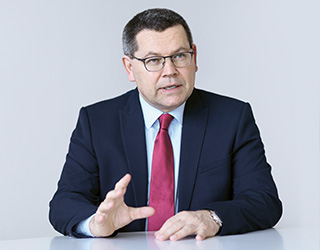Group Underwriting

“Focused and targeted R&D will maintain our market leading ability to steer through allocating capital to risk pools, and distinctively underwrite risks.”
Edouard Schmid
Group Chief Underwriting Officer
Competitive advantage in underwriting
In the world of re/insurance underwriting, Swiss Re can outperform in two ways. First, we can change the capital allocated to particular risk pools as markets move and we develop new insights. Second, we can be selective in underwriting individual risks.
Systematic allocation of capital to risk pools is at the heart of our Group strategy. An annual top-down capital allocation underpins our business planning process; throughout the year, we actively steer our deployed capacity to maximise return. This activity is rooted in our ability to take a forward-looking perspective on the economics of risk pools and allocate capital accordingly.
Risk selection is a capability honed at Swiss Re through more than 150 years of experience. We succeed by continually investing in our ability to align our interests with those of our clients, understand individual risks and their drivers, select good risks and accurately assess the costs of taking a particular one. At its core, this is a knowledge-based capability – combining the art of the underwriter with scientific rigour.
The common thread is our investment in R&D, which equips our underwriters with distinctive knowledge and insights into the future of risk pools. The launch of the Swiss Re Institute in 2017 embodies our commitment to creating and benefiting from cutting-edge knowledge and conducting fundamental research into trends that could have an impact on our business.
Our investment includes 450 people in core and extended R&D teams committed either wholly or partially to developing our knowledge assets. To give just a few examples, in the past year alone we have investigated long-term mortality trends, evaluated the impact of distracted driving, evaluated changes in the propensity to litigate and estimated the impact of changing mid-Atlantic temperatures. We combine data and innovative analytical tools, and partner with academics from institutions around the world, consultants, professionals from all disciplines, start-ups, institutions and others. This translates into real bottom-line impact through services to our clients, automated pricing tools, inputs to underwriters and research behind our forward-looking perspectives on risk pools.
It is this investment in focused and targeted R&D that will maintain our market-leading ability to steer through allocating capital to risk pools, and distinctively underwrite risks.
Underwriting performance in 2017
Notwithstanding the natural catastrophes in 2017, the Group’s overall underwriting performance was solid across all businesses. Financial year results were dominated by insured natural catastrophe losses figuring among the largest on record, and further influenced by a continued softening market environment in 2017.
The Group’s claims ratio for property and casualty increased from 61.2% in 2016 to 82.3% in 2017.
The 2017 loss burden totalled USD 4.7 billion, driven by losses associated with Cyclone Debbie in Australia, hurricanes Harvey, Irma and Maria as well as the Mexico earthquakes and the Californian wildfires.
The total life and health benefits increased from USD 9.0 billion in 2016 to USD 9.2 billion in 2017. The increase was mainly due to the earnings development of US Individual Life transactions that were closed in late 2016, a large transaction win in Europe starting in July 2017 and from Asia, where we experienced very strong organic growth in several business lines.
Market environment and outlook
In recent years, new capital flowing into the industry has depressed prices and driven certain areas of risk pools to unsustainable levels of return. The significant natural catastrophe losses of 2017 have seen a reversal of this trend. We expect this increased pricing discipline to be maintained in the near term, supporting further profitable growth. Overall, we expect a further improvement in pricing, especially in lines directly affected by the 2017 natural catastrophe events.
The underlying pool of insurable risks will continue to grow in the context of the continuing cyclical upswing in the global economy. The small inflation rises of the past year will not significantly impact claims severity in our view, but we remain cautious about potential long-term effects.
Our outlook is more positive than in the last few years, and we see opportunities available to us through three distinctive abilities. Our ability to engage in large and tailored transactions has created a market in which few others are even able to operate. We continue to see growing demand for solutions and services that deploy our R&D to clients. Finally, we retain our ability to rapidly and flexibly deploy capital across industry-leading products and geographic franchises.
We anticipate that our very strong capitalisation will allow us to realise opportunities not available to others. However, we will only seek opportunities where prices meet our hurdle rates.